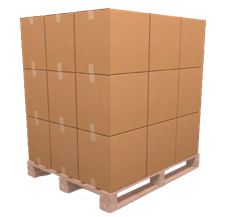
by logisticsplus | Mar 21, 2017 | News
 If you’re new to LTL shipping, here’s a quick primer on the industry, its history, and some tips on how to get the most out of your LTL freight spend. The abbreviation “LTL” stands for “Less Than Truckload.” This refers to a shipment that does not require a full trailer to move. In practice, LTL shipments from multiple shippers are generally combined into a full (or near-full) trailer-load that will move in a pre-defined pickup and delivery network. An LTL shipment is first picked up by a “city driver” who makes his way from shipper to shipper until his trailer is full or his route is completed. Those shipments will be brought back to a local city terminal where they will be moved from the city operation to the “linehaul” (or highway) operation. A linehaul driver will then transport all of the shipments from the origin city to a final destination city (or first to an intermediary consolidation facility). Once at the destination terminal, shipments will be moved back into the city operation for final delivery. While that is an extremely simplified overview, it’s pretty much how it works in a nutshell.
If you’re new to LTL shipping, here’s a quick primer on the industry, its history, and some tips on how to get the most out of your LTL freight spend. The abbreviation “LTL” stands for “Less Than Truckload.” This refers to a shipment that does not require a full trailer to move. In practice, LTL shipments from multiple shippers are generally combined into a full (or near-full) trailer-load that will move in a pre-defined pickup and delivery network. An LTL shipment is first picked up by a “city driver” who makes his way from shipper to shipper until his trailer is full or his route is completed. Those shipments will be brought back to a local city terminal where they will be moved from the city operation to the “linehaul” (or highway) operation. A linehaul driver will then transport all of the shipments from the origin city to a final destination city (or first to an intermediary consolidation facility). Once at the destination terminal, shipments will be moved back into the city operation for final delivery. While that is an extremely simplified overview, it’s pretty much how it works in a nutshell.

Due to the high barrier to entry (building an LTL network takes significant capital investment), a relatively small number of LTL carriers dominate this segment of the transportation industry. In fact, according to SJ Consulting, the top 25 LTL carriers comprise over 90% of the industry. Recent industry consolidation continues to support larger, growing market shares for the biggest LTL carriers such as FedEx Freight, XPO, YRC Freight, Old Dominion, UPS Freight, Estes, and a number of regional players.
The History of LTL Shipping
The U.S. government started regulating the trucking industry in 1935 under the direction of the Interstate Commerce Commission (ICC). The Motor Carrier Act of 1935 required new truckers to seek a “certificate of public convenience and necessity” from the ICC. The act required motor carriers to file their rate tariffs with the ICC 30 days before they became effective. The tariff could then be subject to a challenge by another carrier or railroad which could lead to a suspension of the tariff until an investigation could be carried out. In 1948, the government allowed carriers to fix prices and allowed them to be exempt from any antitrust legislation. For the next 30 years competition was virtually extinguished as the ICC denied applications from new carriers. The industry began to change in the early 1970’s when new administrations implemented a number of acts to reduce price fixing and collective vendor pricing. The final part of the deregulation was the Motor Carrier Act of 1980 which resulted in intense price competition and lower profit margins for the industry; with thousands of new low-cost, non-union carriers entering the market. After 1980, average LTL rates would continue to fall while the number of LTL carriers doubled between 1980 and 1990.
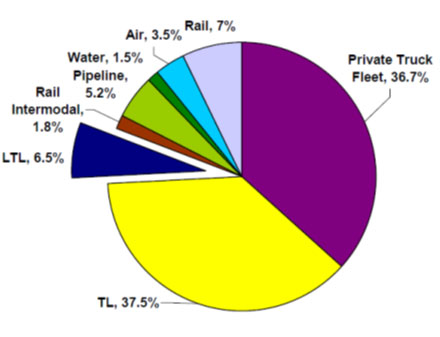 Today, the $35 billion LTL industry remains an important, but small component of the $700 billion total U.S. freight transportation pie; but it is seen as a vital component for many shippers’ supply chains – particularly those based on just-in-time and continuous replenishment systems. The American Trucking Association (ATA) regularly publishes reports on the state of the trucking industry that includes some of these statistics.
Today, the $35 billion LTL industry remains an important, but small component of the $700 billion total U.S. freight transportation pie; but it is seen as a vital component for many shippers’ supply chains – particularly those based on just-in-time and continuous replenishment systems. The American Trucking Association (ATA) regularly publishes reports on the state of the trucking industry that includes some of these statistics.
Quick Tips for New LTL Shippers
If you’re new to LTL freight shipping and trying to develop a good approach to getting the most out of your freight spend, here are a few tips to get you started.
- Fill out your bill of lading correctly. A bill of lading (BOL) works as a receipt for the goods shipped, indicates contracted details between carrier and shipper, defines a consignee, and functions as a document of title. An accurate BOL informs the carrier how the shipment should be handled and billed. Be sure to place the correct NMFC item number and freight classification for your shipment on your BOL.
- Know your freight class. LTL shipments are based on a system of freight classifications (freight class). There are 18 different freight classes; lower classes represent dense freight that isn’t easily damaged and can be handled easily. Higher freight classes represent lighter, less dense freight that is fragile and difficult to move. Higher classes equate to higher rates. Incorrectly classifying your freight can lead to “re-classification” fees.
- Avoid unnecessary accessorial fees. Accessorial fees compensate carriers for additional services and equipment beyond their normal shipping procedures. Accessorial fees can be added if the shipper misrepresents a shipment’s freight classification, if a driver is turned away from a delivery or the consignee is not present, if the BOL is not filled out correctly, and in many other scenarios.
- Use pallets when possible. Pallets make shipments easier for carriers to move. Use pallets when pieces fit squarely within the pallet’s edges, height and width of a shipment are similar, and if the individual pieces in a load exceed 100 pounds. Also keep in mind that the weight of the pallet should be included in the weight you show on your BOL.
- It’s all about the net price. To determine your net LTL price, several factors come into play: origin and destination, weight, freight class, density, base rates, discounts, minimum charges, and accessorial fees. Oftentimes shippers focus on the amount of discount they are receiving, but discounts can be misleading because there are many different base rates upon which the discounts may apply. That’s why it is important to focus on only the net price, and not the discount.
- Work with a 3PL partner that has LTL expertise. A good 3PL partner with experience managing LTL services and carriers can help shippers properly classify their products, complete accurate bills of lading, avoid accessorial fees, negotiate great rates, and go-to-bat when issues arise. The freight experts at Logistics Plus have been managing LTL shipping for companies, large and small, for over 20 years. We’d love to help you manage your LTL shipping too!


by logisticsplus | Mar 2, 2017 | News
FOR IMMEDIATE RELEASE
Logistics Plus Recognizes 2016 National and Regional LTL Carriers of the Year
FedEx Freight Presented with National Award and Dayton Freight Presented with Regional Award.
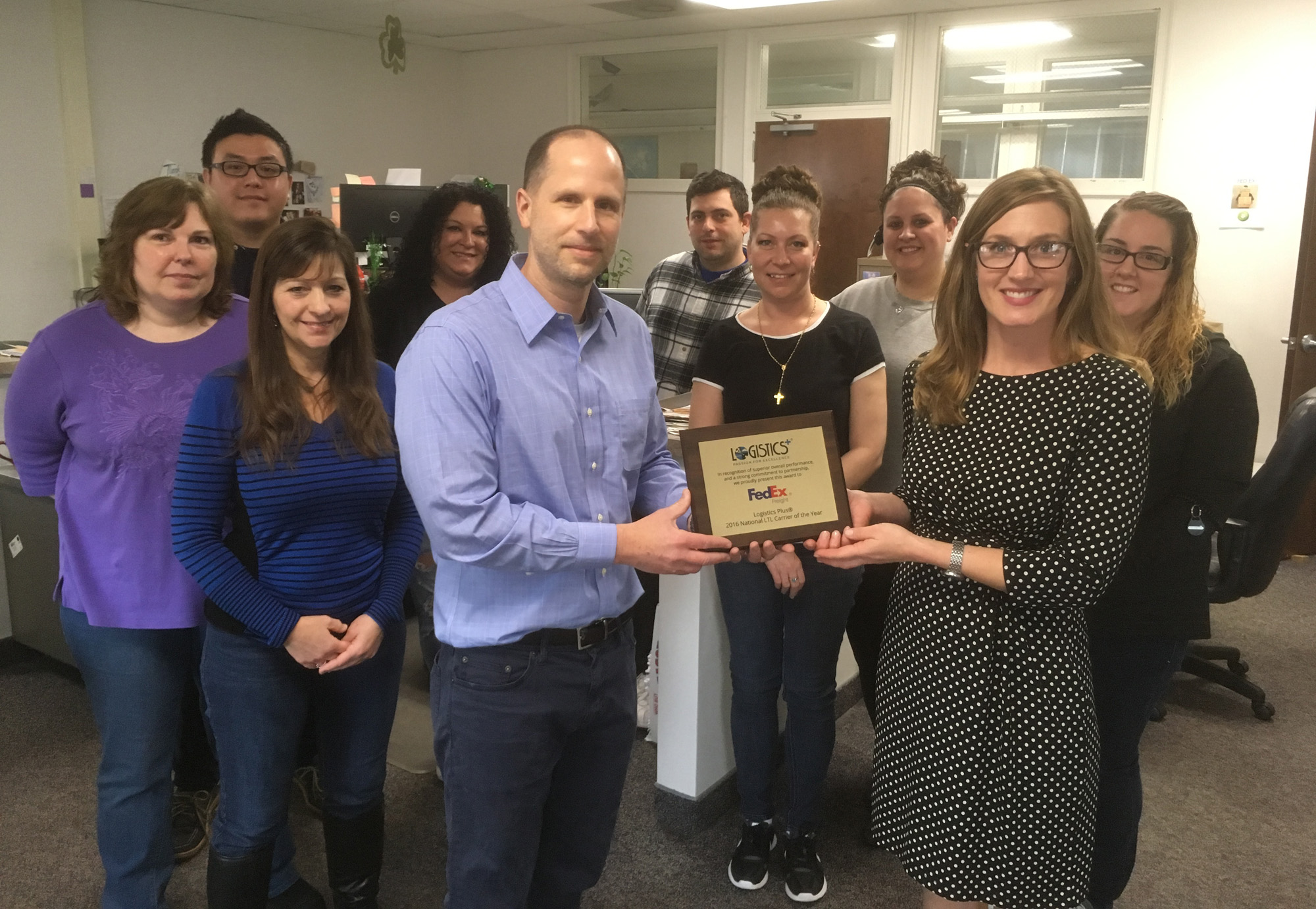
The LP team presents Monica Fronzaglio, worldwide account manager for FedEx Services, with its National LTL Carrier Award
ERIE, PA (March 2, 2017) – Logistics Plus Inc., a leading worldwide provider of transportation, logistics and supply chain solutions, recently recognized two of its less-than-truckload (LTL) carriers for superior results and performance in 2016. The annual awards were presented to the following carriers in each of two categories:
- FedEx Freight was named the 2016 Logistics Plus National LTL Carrier of the Year (Estes Express and UPS Freight were both runners up in this category)
- Dayton Freight Lines was named the 2016 Logistics Plus Regional LTL Carrier of the Year (Ward Transport & Logistics and New Penn Motor Express were both runners up in this category)

The LP team presents Patty Ash, corporate account manager for Dayton Freight, with its Regional LTL Carrier Award
Performing as a top North American freight brokerage firm, Logistics Plus LTL services are delivered through its proprietary eShipPlus™ transportation management system (TMS) – a complimentary online platform made available to all of its LTL customers. Its annual LTL carrier awards are based on internal and external assessments of the following performance criteria:
- Annual Share of Business and Growth
- Price Competitiveness
- Service Performance
- Billing Accuracy
- Customer Service
- Account Representation
“Logistics Plus has been buying, managing, and delivering LTL services to our many customers for 20 years. Although today we provide many other logistics solutions, LTL remains one of our core offerings,” said Scott Frederick, vice president of marketing and LTL carrier relations for Logistics Plus. “Having great, cooperative LTL carrier partners is critical to our LTL services program. We looked at annual performance reports, we polled our internal operations and accounting stakeholders, and we surveyed our end customers; and FedEx Freight and Dayton Freight both came out on top. I am grateful for the support we receive from all of our LTL carrier partners, but I would especially like to thank and congratulate FedEx Freight and Dayton Freight for their excellent performance in 2016.”
About FedEx Freight
FedEx Freight is the largest LTL carrier in North America with service throughout the U.S., Canada, Mexico and Puerto Rico, and to the U.S. Virgin Islands. FedEx Freight offers two reliable options: FedEx Freight® Priority, with the fastest published transit times of any nationwide less-than-truckload (LTL) service, and FedEx Freight® Economy for basic LTL freight shipping needs.
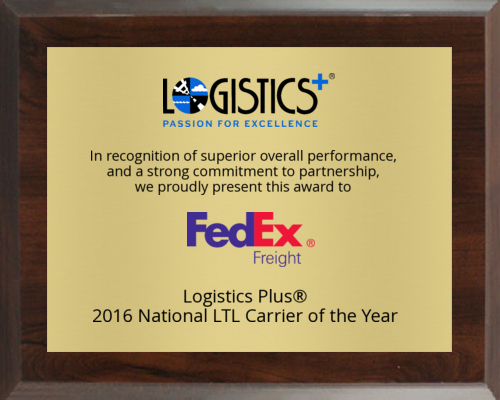
About Dayton Freight Lines
Founded in 1981, Dayton Freight is a private LTL freight carrier headquartered in Dayton, Ohio. With 50 Service Centers in the Midwest region, Dayton Freight offers shippers 1 or 2 day service to thousands of points throughout a 13 state area. With our Strategic Alliance Network, we can serve all of the United States, Canada, Mexico, Puerto Rico and Guam.
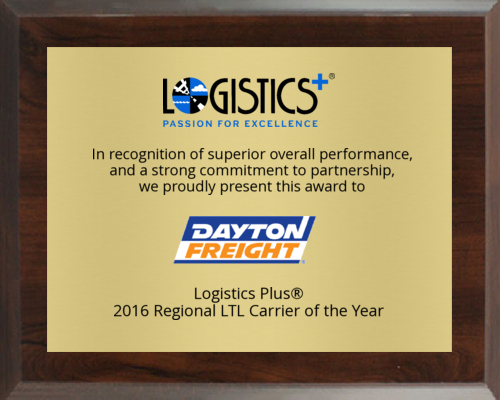
About Logistics Plus Inc.
Logistics Plus Inc. provides freight transportation, warehousing, global logistics, and supply chain management solutions through a worldwide network of talented and caring professionals. Founded in Erie, PA by local entrepreneur, Jim Berlin, 20 years ago, Logistics Plus is a fast-growing and award-winning transportation and logistics company. With a strong passion for excellence, its 400+ employees put the “Plus” in logistics by doing the big things properly, and the countless little things, that together ensure complete customer satisfaction and success.
The Logistics Plus® network includes offices located in Erie, PA; Alma, AR; Little Rock, AR; Los Angeles, CA; Riverside, CA; San Francisco, CA; Visalia, CA; Atlanta, GA; Chicago, IL; Detroit, MI; Kansas City, MO; Charlotte, NC; Lexington, NC; Buffalo, NY; Cleveland, OH; Charleston, SC; Greenville, SC; Nashville, TN; Dallas, TX; Fort Worth, TX; Houston, TX; Laredo, TX; Madison, WI; Bahrain; Belgium; Canada; Chile; China; Colombia; Egypt; France; Germany; India; Indonesia; Kazakhstan; Kenya; Libya; Mexico; Poland; Saudi Arabia; South Sudan; Turkey; UAE; and Uganda; with additional agents around the world. For more information, visit www.logisticsplus.com or follow @LogisticsPlus on Twitter.
###
Media Contact:
Scott G. Frederick
Vice President, Marketing
Logistics Plus Inc.
(814) 240-6881
scott.frederick@logisticsplus.com
Click image below to download the Logistics Plus logo:

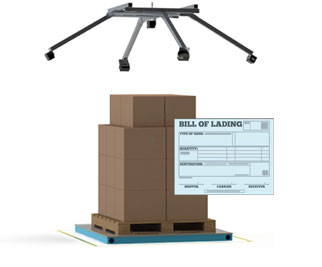
by logisticsplus | Jan 12, 2017 | News
 Bill of lading accuracy is as important as ever. The BOL is a legally required document that must be completed before a freight shipment is hauled. A BOL protects both the carrier and the shipper. The document contains detailed information on the type, quantity and destination of the goods being carried. The issuance of the BOL is proof that the carrier has received the goods from the shipper, or their 3PL, in apparent good order and condition, as handed over by the shipper.
Bill of lading accuracy is as important as ever. The BOL is a legally required document that must be completed before a freight shipment is hauled. A BOL protects both the carrier and the shipper. The document contains detailed information on the type, quantity and destination of the goods being carried. The issuance of the BOL is proof that the carrier has received the goods from the shipper, or their 3PL, in apparent good order and condition, as handed over by the shipper.
Until recently, LTL carriers tolerated some “bending of the rules” regarding accurate freight weights, classifications, and dimensions detailed on the BOL. New tools are helping carriers efficiently and objectively assess freight. Many LTL terminals now use forklifts with embedded scales. Terminals are also using ceiling-mounted systems that measure the dimensions and density of every piece of freight.
As a result of these new technologies, and recent rules tariff changes, carriers are tolerating BOL discrepancies no longer. Today, carriers are pursuing every penny of revenue they can get. LTL carriers, in particular, are strictly enforcing terms and policing discrepancies between reported and actual freight characteristics, leading to many unexpected fees for shippers. Freight descriptions that you may have used for years without problems might start triggering fees if they under-report any aspect of your freight’s true profile.
An accurate bill of lading is your best defense against these “weight & inspection” – or “W&I” – fees, and against possible rate changes resulting from “re-weighs” or “re-classifications.” Make sure to measure the dimensions of your LTL freight, including packaging, to the furthermost point in each direction. Some shippers measure the pallet rather than the freight when calculating dimensions. If the freight overhangs the pallet, the overhang must be included in the measurements.
July 2020 Update: With the NMFC now designating more commodities for density-based classifications, preparing an accurate BOL is as important as ever. If you note the wrong weight for a density-based product on your bill of lading, there is a good chance that the LTL carrier will re-weigh your shipment and charge you the higher rate using the same freight class you designated on your BOL rather than adjusting the freight class according to the new weight and dimensions. Specifically, this is how one carrier has worded their new rules tariff item specific to this situation: “In the case where the weight is changed on a shipment that is a density-based item in NMFC, the freight classification on the original bill of lading will be used unless the shipper or consignee can produce irrefutable supporting documentation showing clear evidence of the LxWxH and corresponding weight of each handling unit of the shipment.”
Logistics Plus stands ready to help shippers any way it can to avoid W&I fees. Our North American (NAD) operations team can provide consultation on accurate NMFC freight classifications and freight density calculations. We notify you whenever a carrier assesses an unintended W&I fee, and we manage the dispute if you have evidence the fee is not valid.
The freight experts at Logistics Plus will be happy to help you with any questions or issues regarding freight characteristics and bill of lading accuracy. Contact us using the button below or email us at nadops@logisticplus.net if you have any of these types of questions.

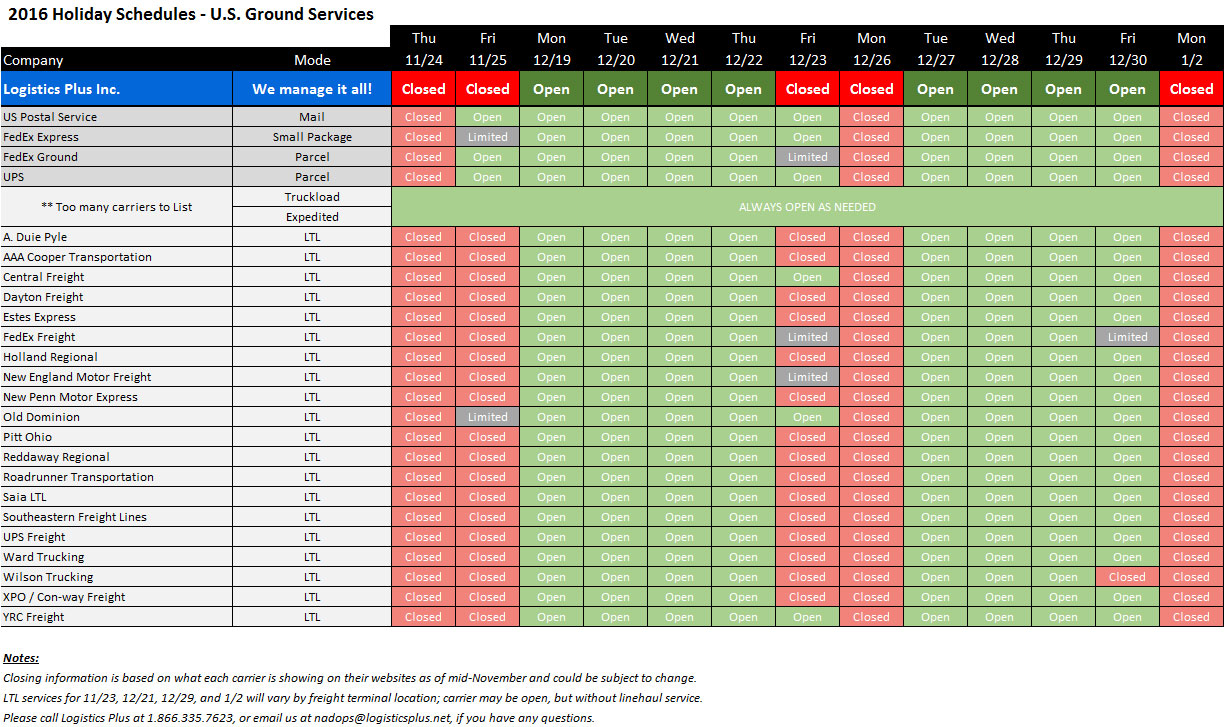
by logisticsplus | Nov 17, 2016 | News
U.S. Holiday schedules for Logistics Plus and ground carriers
As the holidays approach, we want to help you avoid any unnecessary shipping delays over the next few weeks. Shown below is the holiday schedule for U.S.-based Logistics Plus offices and warehouse locations, as well as the top U.S. ground (parcel and LTL) carriers. If you have any special transportation needs, or expedited shipping requests, please contact Logistics Plus in advance of the office closings noted below. You can use the Logistics Plus online global directory to find any of our people or our locations. You can also reach our North American freight division by calling 1.866.335.7623 or emailing us at nadops@logisticsplus.com.

Click image to see a slightly larger version of table.

by logisticsplus | Nov 16, 2016 | News
Wondering whether your domestic freight shipment should move via parcel, less-than-truckload (LTL), or full-truckload (FTL) carrier? Here’s a quick cheat-sheet with some PROs and CONs to each of these ground transportation modes.
 Parcel Shipping: Shipments under 150 pounds and shipped in cartons (less than 108 inches long and 67 inches wide), rather than on a pallet, are often moved via Parcel shipping with carriers such as USPS, UPS, FedEx or regional courier services.
Parcel Shipping: Shipments under 150 pounds and shipped in cartons (less than 108 inches long and 67 inches wide), rather than on a pallet, are often moved via Parcel shipping with carriers such as USPS, UPS, FedEx or regional courier services.
- PROS: Fast service, many delivery options, readily available, lower shipping costs on smaller shipments.
- CONS: More chance of being lost or damaged, lower carrier liability limits per pound, few carrier options.
 Standard Less-Than-Truckload (LTL) Shipping: Shipments between 150 and 5,000 pounds are generally better moved using standard LTL carrier pricing with LTL carriers such as FedEx Freight, UPS Freight, YRC Freight, or regional freight carriers.
Standard Less-Than-Truckload (LTL) Shipping: Shipments between 150 and 5,000 pounds are generally better moved using standard LTL carrier pricing with LTL carriers such as FedEx Freight, UPS Freight, YRC Freight, or regional freight carriers.
- PROS: Relatively fast service, good availability, fewer damages, good with B2B deliveries, higher carrier liability limits pound.
- CONS: Complex pricing structure, higher shipping costs, not always suitable for non-palletized freight, not always great with B2C deliveries, minimal carrier options.
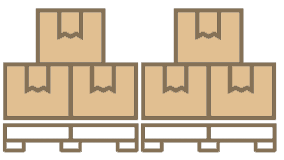 Volume Less-Than-Truckload (LTL) Shipping: Shipments between 5,000 and 10,000 pounds, or taking up more than 6 pallet spaces, are often moved more cost-effectively with a “volume” or “spot” quote. In these situations, the carrier will analyze the weight and dimensions of the shipment and provide a competitive “all-in” rate quote.
Volume Less-Than-Truckload (LTL) Shipping: Shipments between 5,000 and 10,000 pounds, or taking up more than 6 pallet spaces, are often moved more cost-effectively with a “volume” or “spot” quote. In these situations, the carrier will analyze the weight and dimensions of the shipment and provide a competitive “all-in” rate quote.
- PROS: All of the above, plus this approach will generally produce a lower price than standard LTL shipping rates.
- CONS: Often predicated on when or where LTL carrier has equipment available and need for more freight volume, getting quotes takes more time.
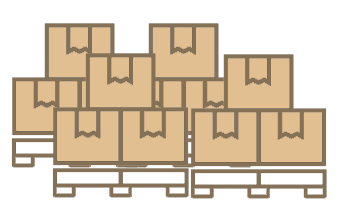 Partial Truckload Shipping: Shipments between 10,000 and 20,000 pounds, or taking up more than 10 pallet spaces, are often moved more cost-effectively as a partial truckload. In these situations, the truckload carrier will analyze the weight and dimensions of the shipment and provide a competitive “all-in” rate quote.
Partial Truckload Shipping: Shipments between 10,000 and 20,000 pounds, or taking up more than 10 pallet spaces, are often moved more cost-effectively as a partial truckload. In these situations, the truckload carrier will analyze the weight and dimensions of the shipment and provide a competitive “all-in” rate quote.
- PROS: Generally produces a lower pricing than standard or volume LTL shipping rates, since shipment only takes up part of the trailer, carrier can sell remaining capacity to another customer to share the costs, many more carrier options.
- CONS: Finding right carrier with capacity is often difficult, predicated on when or where carrier has equipment available, getting quotes takes more time, must vet carrier to ensure safe and reliable.
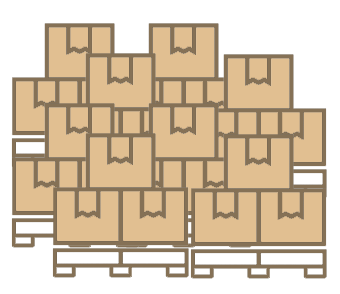 Full Truckload (FTL) Shipping: Shipments over 20,000 pounds are often moved more cost-effectively as a full truckload. In these situations, the carrier will analyze the weight and dimensions of the shipment and provide a competitive “all-in” rate quote.
Full Truckload (FTL) Shipping: Shipments over 20,000 pounds are often moved more cost-effectively as a full truckload. In these situations, the carrier will analyze the weight and dimensions of the shipment and provide a competitive “all-in” rate quote.
- PROS: Generally the most cost-effective way to ship per pound, less susceptible to damages because freight is normally moved door-to-door on one trailer (no re-handlings), many more carrier options.
- CONS: Finding right carrier with capacity is often difficult, predicated on when or where carrier has equipment available, getting quotes take more time, must vet carrier to ensure safe and reliable.
Need help deciding how best to ship your freight the most using the most cost-effective ground transportation mode? Let Logistics Plus help you with a risk-free freight analysis or freight quote.



 If you’re new to LTL shipping, here’s a quick primer on the industry, its history, and some tips on how to get the most out of your LTL freight spend. The abbreviation “LTL” stands for “Less Than Truckload.” This refers to a shipment that does not require a full trailer to move. In practice, LTL shipments from multiple shippers are generally combined into a full (or near-full) trailer-load that will move in a pre-defined pickup and delivery network. An LTL shipment is first picked up by a “city driver” who makes his way from shipper to shipper until his trailer is full or his route is completed. Those shipments will be brought back to a local city terminal where they will be moved from the city operation to the “linehaul” (or highway) operation. A linehaul driver will then transport all of the shipments from the origin city to a final destination city (or first to an intermediary consolidation facility). Once at the destination terminal, shipments will be moved back into the city operation for final delivery. While that is an extremely simplified overview, it’s pretty much how it works in a nutshell.
If you’re new to LTL shipping, here’s a quick primer on the industry, its history, and some tips on how to get the most out of your LTL freight spend. The abbreviation “LTL” stands for “Less Than Truckload.” This refers to a shipment that does not require a full trailer to move. In practice, LTL shipments from multiple shippers are generally combined into a full (or near-full) trailer-load that will move in a pre-defined pickup and delivery network. An LTL shipment is first picked up by a “city driver” who makes his way from shipper to shipper until his trailer is full or his route is completed. Those shipments will be brought back to a local city terminal where they will be moved from the city operation to the “linehaul” (or highway) operation. A linehaul driver will then transport all of the shipments from the origin city to a final destination city (or first to an intermediary consolidation facility). Once at the destination terminal, shipments will be moved back into the city operation for final delivery. While that is an extremely simplified overview, it’s pretty much how it works in a nutshell. Today, the $35 billion LTL industry remains an important, but small component of the $700 billion total U.S. freight transportation pie; but it is seen as a vital component for many shippers’ supply chains – particularly those based on just-in-time and continuous replenishment systems. The American Trucking Association (ATA) regularly publishes reports on the state of the trucking industry that includes some of these statistics.
Today, the $35 billion LTL industry remains an important, but small component of the $700 billion total U.S. freight transportation pie; but it is seen as a vital component for many shippers’ supply chains – particularly those based on just-in-time and continuous replenishment systems. The American Trucking Association (ATA) regularly publishes reports on the state of the trucking industry that includes some of these statistics.












 Parcel Shipping: Shipments under 150 pounds and shipped in cartons (less than 108 inches long and 67 inches wide), rather than on a pallet, are often moved via Parcel shipping with carriers such as USPS, UPS, FedEx or regional courier services.
Parcel Shipping: Shipments under 150 pounds and shipped in cartons (less than 108 inches long and 67 inches wide), rather than on a pallet, are often moved via Parcel shipping with carriers such as USPS, UPS, FedEx or regional courier services.
 Volume Less-Than-Truckload (LTL) Shipping: Shipments between 5,000 and 10,000 pounds, or taking up more than 6 pallet spaces, are often moved more cost-effectively with a “volume” or “spot” quote. In these situations, the carrier will analyze the weight and dimensions of the shipment and provide a competitive “all-in” rate quote.
Volume Less-Than-Truckload (LTL) Shipping: Shipments between 5,000 and 10,000 pounds, or taking up more than 6 pallet spaces, are often moved more cost-effectively with a “volume” or “spot” quote. In these situations, the carrier will analyze the weight and dimensions of the shipment and provide a competitive “all-in” rate quote.
 Partial Truckload Shipping: Shipments between 10,000 and 20,000 pounds, or taking up more than 10 pallet spaces, are often moved more cost-effectively as a partial truckload. In these situations, the truckload carrier will analyze the weight and dimensions of the shipment and provide a competitive “all-in” rate quote.
Partial Truckload Shipping: Shipments between 10,000 and 20,000 pounds, or taking up more than 10 pallet spaces, are often moved more cost-effectively as a partial truckload. In these situations, the truckload carrier will analyze the weight and dimensions of the shipment and provide a competitive “all-in” rate quote.
 Full Truckload (FTL) Shipping: Shipments over 20,000 pounds are often moved more cost-effectively as a full truckload. In these situations, the carrier will analyze the weight and dimensions of the shipment and provide a competitive “all-in” rate quote.
Full Truckload (FTL) Shipping: Shipments over 20,000 pounds are often moved more cost-effectively as a full truckload. In these situations, the carrier will analyze the weight and dimensions of the shipment and provide a competitive “all-in” rate quote.

